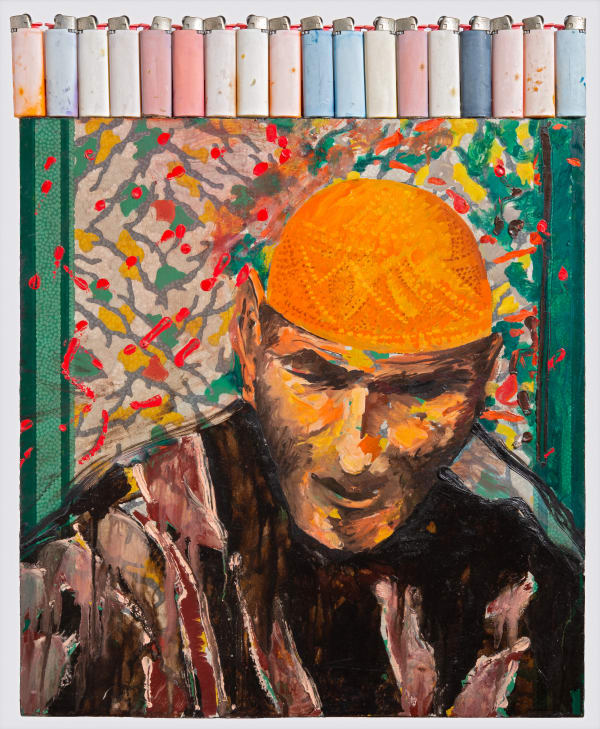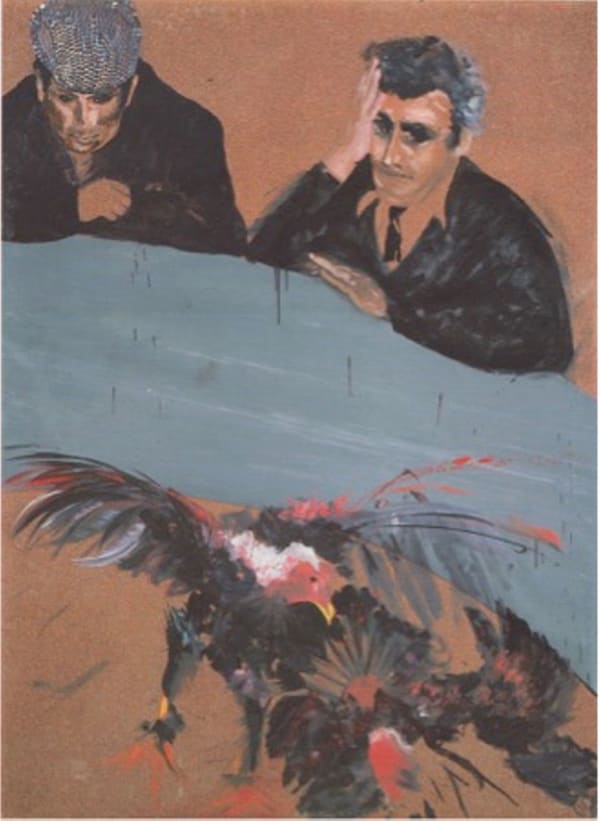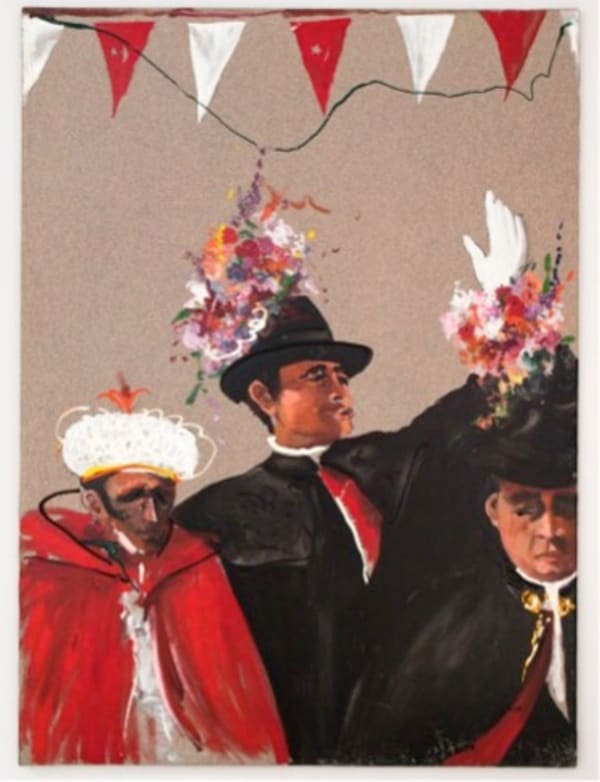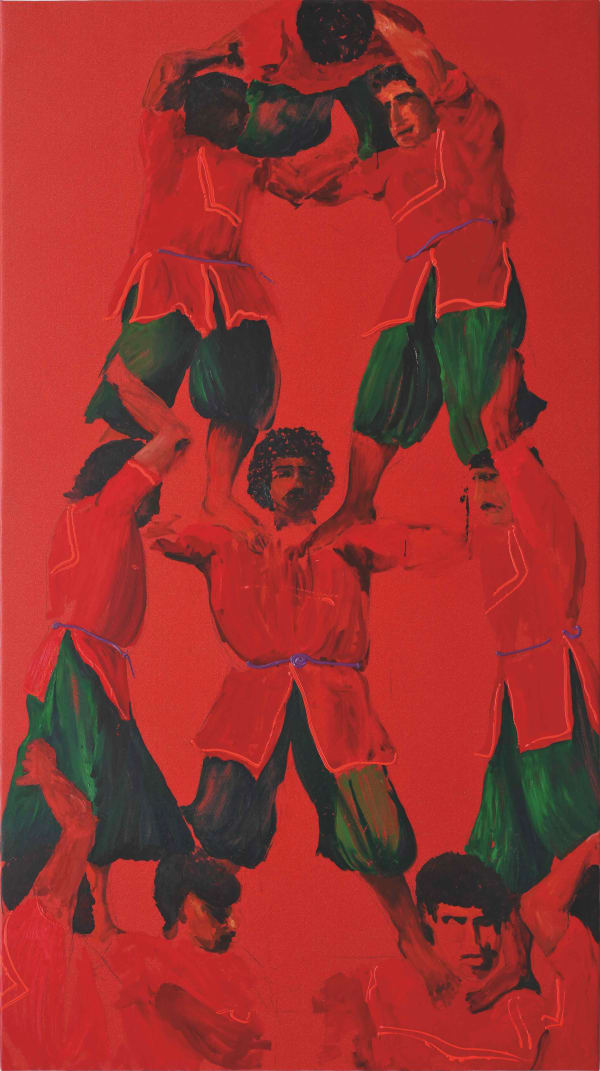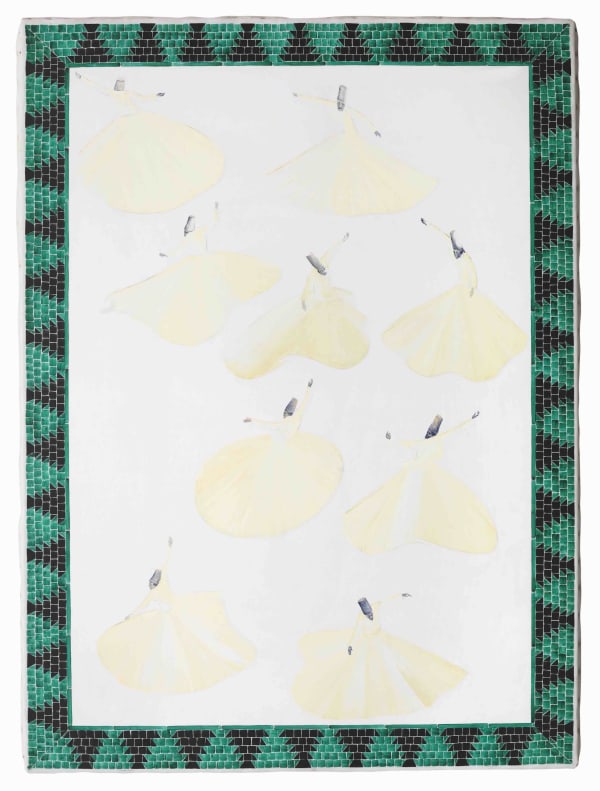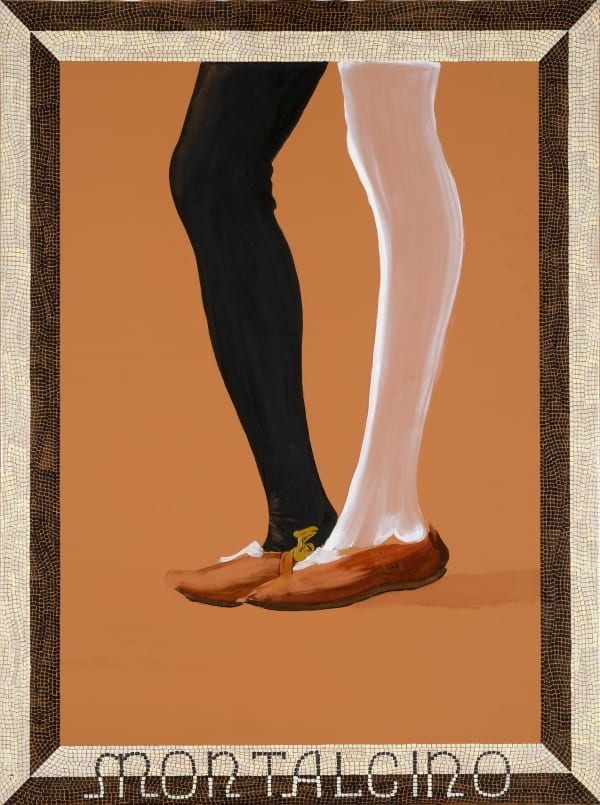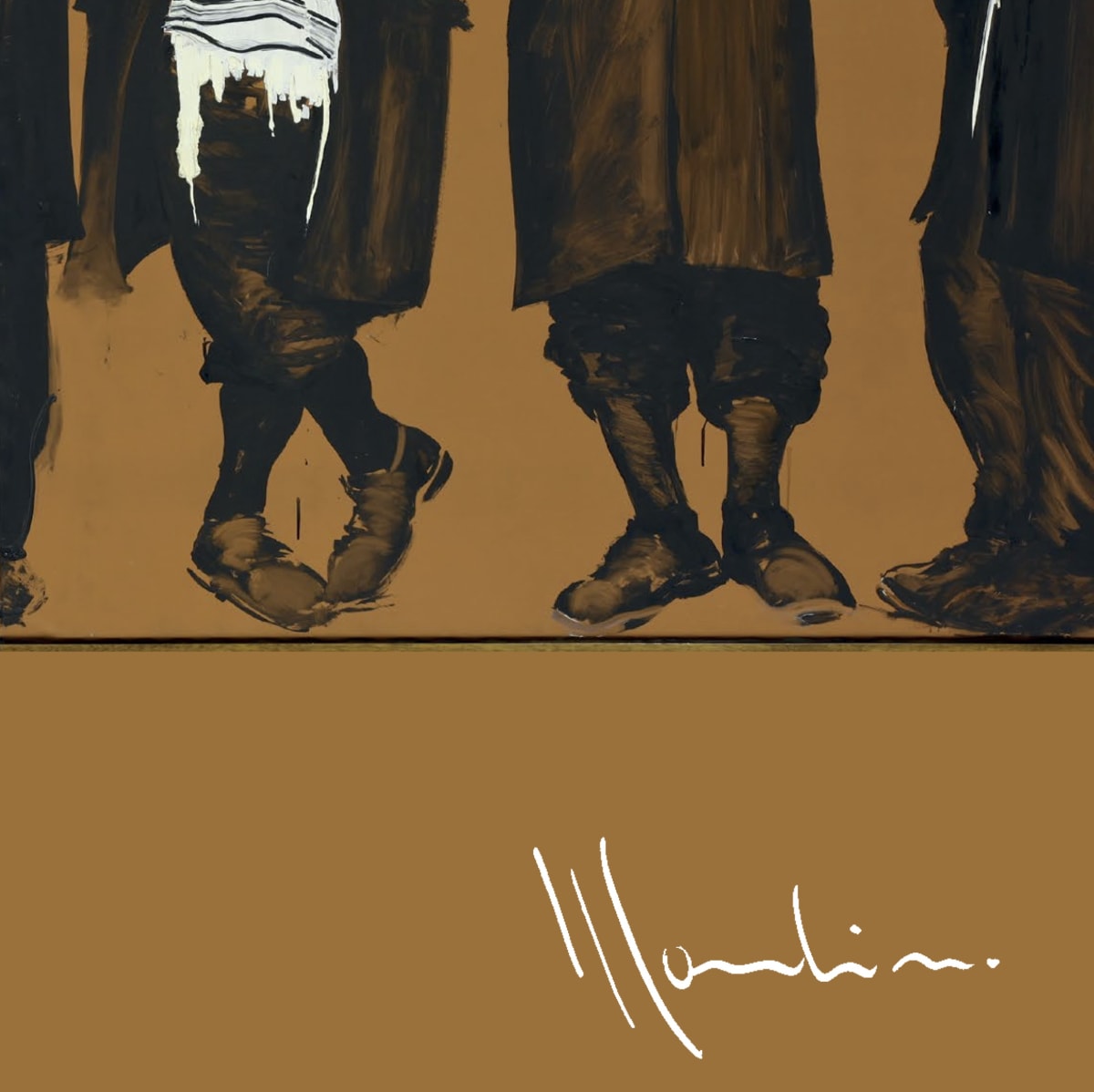Aldo Mondino Italian, 1938-2005
Aldo Mondino was born in 1938 in Turin, where he died in 2005.
In 1959 he moved to Paris where he attended the studio of William Heyter, the ‘Ecole du Louvre’, and the mosaic course at the Academy of Fine Arts with Severini and Licata.
In 1960 he returned to Italy, where he began to exhibit his work at the Galleria L'Immagine in Turin (1961) and the Galleria Alfa in Venice (1962). His meeting with Gian Enzo Sperone, director of the Galleria Il Punto, represented a turning-point in his artistic career and marked the beginning of a long collaboration that still continues today. He held a series of important solo exhibitions at the Galleria Stein in Turin, the Studio Marconi in Milan, the Galleria La Salita in Rome and the Galleria Paludetto in Turin.
Mondino’s major exhibitions include two participations in the Venice Biennale in 1976 and 1993 and solo exhibitions at the Museum für Moderne Kunst - Palais Liechtenstein in Vienna (1991), the Sultanahmet Topkapi Museum in Istanbul (1992, 1996), the Jewish Museum of Bologna (1995) and the Galleria Civica d'Arte Moderna in Trento (2000).
His works are part of the permanent collections of leading Italian and international museums and many private collections.
-

Close Quarters
19 Jun - 25 Sep 2020LONDON - ML Fine Art presents a group exhibition of Italian and international twentieth-century art. Complemented by a selection of modern design from Madrid, London and New York based gallery Portuondo, Close Quarters alludes to the household of an imagined collector.Read more
The sensual encounter with this eclectic collection delineates an imperfect portrait, which the viewer is invited to complete. Simultaneously intimate and startingly impersonal, the objects on view invite speculative incursions on the life of our unnamed protagonist: what did he buy, and what did he inherit? What has he already sold? -

Aldo Mondino: Linoleum | Milan
3 Apr - 17 May 2019The current exhibition organised by ML Fine Art in Milan focuses on the extensive production of Aldo Mondino's last years of activity, engaging a critical essay and a memoir by Gian Enzo Sperone with seminal paintings by Mondino on linoleum.Read more -

Aldo Mondino: Linoleum | London
13 Feb - 22 Mar 2019The current exhibition organized by ML Fine Art in London focuses on the extensive production of Aldo Mondino's last years of activity, engaging a critical essay and a memoir by Gian Enzo Sperone with seminal paintings by Mondino on linoleum.Read more
In 1959 I move to Paris where I attend Heyter’s courses at Atelier 17 and at the Ecole du Louvre, as well as mosaic courses at the academy with Severini and his assistant, Licata. My friendship with Tancredi, the encounters with Jouffroy, ErrÚ, Lebel, as well as those with the affirmed masters Matta and Lam are all crucial to my formation. In 1960, thanks to Tancredi, I succeed for the first time in exhibiting my works in a space, the Galerie Bellechasse, with paintings clearly influenced by Surrealism. At the same time, there is a show organized by Jouffroy and lebel at the Galerie des 4 Saisons, whose title, Anti-Procès, has a strong political connotation.
In 1961, I return to Italy to do military service. Thanks to Antonio Carena, an artist from Turin and owner of the Galleria L’Immagine, I have my first solo show, with works that still reflect my Parisian period. In 1962, Enrico Crispolti organizes a show in Venice at the Galleria Alpha with a series of special works: large writings with, inside each letter, figurines that can recall illuminated codes. Aldo Mondino, Nome Cognome Indirizzo, La Famiglia, La Scuola, La Religione, La morale e Il Servizio militare are a few of the titles. The encounter with Gian Enzo Sperone, director of the Galleria Il Punto, owned by Remo Pastori, represents a very important moment I display the series Tavole anatomiche, panels of painting on masonite, representations of a human body, a microcosm of the society we live in. At the same time, through my work, I elaborate the idea that the public is no longer a passive spectator, but an active participant in the work of art.
At the Galleria Sperone, in 1964, the ìquadri a quadrettiî have as their subject the emblematic image found in a work by the painter Casorati: a mother holding a child in her arms. In the same year, at La Salita in Rome, I exhibit works treated similarly but with references taken from the typical subjects used in drawing manuals, such as L’Aereoplano, Il pittore in erba, Il serpente, Il portiere.
The following year I am at the Galleria Stein in Turin: a reflexion on painting, paintings with balloons, Le cadute, scales where colours seem to slide onto the surface. In 1966, I exhibit at the Galleria Marconi in Milan, after an interesting intervention in Turin with a red thread crossing the city streets at a height of 160 centimetres above ground level, connecting the three galleries: Sperone, Il Punto, Christian Stein. At Marconi’s again in 1967, then the solo show at the Galleria Lia Rumma in Naples. The collective show at the Arco d’Alibert, in 1968, goes back to my stay in Rome, then at the Galleria Torre in Torino; on that occasion I create the Torre di torrone and the series of Caramelle. In 1969, again at the Arco d’Alibert, with Ittiodromo I display real fish, with blood. Afterwards, I rent a boat on the Tiber river where I install several Caramelle. Then I create Mamma, Agnelli e Porcòdio, presented in Rome; after having been exhibited in a gallery in Brescia, the latter is confiscated and I am condemned to pay a fine for blasphemy.
From that moment on, after a year-long silence, I make a friend of mine lend me his house, so as not to exhibit in traditional circuits. The King are born. The year of 1970 is entirely dedicated to this series, it is my first encounter with painting and with myself.
In 1972 I return to Paris, waiting for painting to be re-evaluated.
In the same year, at the Galleria L’Uomo e l’Arte in Milan, the 12 King, my property by now, are reproposed, and later presented at the Galleria LP220 in Turin, where I also had a “lay” baptism performed for my son.
In Paris, dedicating myself intensely to painting, I work from the end of 1973 through the whole year of 1980; this effort takes form on the occasion of the 1976 Venice Biennale, where my efforts are concentrated on a rigorously philological parallelism between my art and Schonberg’s compositions.
The exhibition Mythologies quotidiennes at the Musée d’Art Moderne of Paris is held in 1977. The series of the Tour Eiffel, again from the Parisian period, with titles such as Le Tout Près War, is realized for the most part with the technique of engraving and becomes a kind of quotation of certain Expressionist images.
In 1980 I realize two exhibitions at the Galleria La Salita in Rome and at the Galerie Flinker in Paris. I paint the most important shipwrecks in history with a technique similar to engraving.
In 1981 and in 1983 I realize two solo shows at the Studio De Ambrogi in Milan. The first, a series of applauding hands and a large engraving on glass that has as its subject a man climbing; the second, the series of Angels.
Paintings with rural themes, that cite the so-called 19th century realism, veiled in melancholy, of Millet - Millet une nuit - mark, in my poetic course, the awareness of the end of the Industrial Age’s historical period in Western civilization. Between 1984 and 1985, I realize two exhibitions at Franz Paludetto’s. I approach Oriental suggestions like a Western-world artist, just as 19th century artists had done, for example, Delacroix.
The time of real voyages comes later, in an Orient that starts in Morocco and continues in Palestine, where I perceive a fascinating parallelism between prayer and the intensity of attention experienced in the act of painting conceptually. And here I become enamoured with prayer as exalted in dervishes’ dances. In 1990, at Sperone Westwater Gallery in New York, I present a series that portrays thirty-six Sultani, all having lived between 1200 and 1920. I have always been a collector of writers’, musicians’ and painters’ autographs.
This fact gives origin to the idea of portraits (Delacroix, Ingres, Satie, Mozart), exhibited at Cleto Polcina in Rome, and realized in near-monochrome solutions, like busts. This is followed by the show at the fondazione Mudima in Milan, and others in Chicago, Geneva, Paris, Vienna, London. The discourse on Orientalism includes even carpets arranged in lively coloured wall compositions realized on Eraclite, an industrial material used in construction. In 1993, at the Venice Biennale curated by Achille Bonito Oliva, in a personal exhibition hall, I present a series of large-size works that represent dancing dervishes; next to these, works made with sugar cubes, carpets and a large chandelier made of wrought iron and ball-point pens entitled Jugen Stilo. On that occasion, authentic dervishes danced before an audience in a highly enthralling atmosphere.
My great love for Spain is born with the series of bulls and toreadors, that for a certain period existed side by side with my love for the Orient, for literary quotation... From the Museo Laboratorio of the Università La Sapienza in Rome, to the show at the Studio Barnabò in Venice and, in Bologna, at the Galleria Spazia, up to the one at the Topkapi Museum in Istanbul, the thematic issues share a common line of thought.
The idea of realizing three-dimensional works has always accompanied my creative course. The first works are produced with various materials, including chocolate (Scultura un corno). The subjects, as in the series of carpets, are fruit of that ìshort-sightedî dimension, of that ìdistanceî that makes me see a distant object become something else when seen up close. Many works are cast in bronze years after the originaI project. I am very fond of La mamma di Boccioni, for example, in bronze, that originated with a version in mint-flavoured candy, to which I added two bowling balls for breast, but also Torso torsolo, a bust weighing three-hundred kilograms that I created in continuity with the older Busto Arsizio.
In the summer of 1996, Alessandro Bagnai organizes a show in Siena where I worked with great enthusiasm, uniting two of my passions: bullfights and the Palio. In 1997 the themes I prefer are the musicians of the Gnawa confraternity and the North African acrobatic dancers that perform in the Danse des Jarres (ACP Gallery of Saltzburg, Galleria Susanna Orlando in Forte dei Marmi, Chiesa Sant’Arcangelo - Giardino Residenza Municipale - Galleria Astuni in Fano). In Fano I presented a preview of the large sculpture Dino Jarre. In the Chiostri di San Domenico and in the synagogue of Reggio Emilia, with the title Mazel Tov, I exhibited works that refer to some of my favourite themes, ineluding that of Hebrewism.
In 1998 I was present in Bologna with the Galleria Astuni in a solo show at the Arte Fiera, in Bruxelles in Mediterranea and at the Galerie Artscope, again in Bruxelles. In 1999 at the Galleria Marconi in Milan for the Fondazione Maimeri with a series of drawings and sculptures on the theme of dance: Arabesque.
Two important shows in Milan at the Galleria 1000eventi and one in Rome at the Galleria Sperone entitled The Byzantine World: the common characteristic of these shows is to have used only chocolates especially made by Peyrano, in Turin.
In the year 2000 the first trip to India and show entitled Flovers at the Birla Academy of Calcutta. In Trento, in the month of June, the show entitled Dall’Acrilico allo Zucchero, curated by Vittoria Coen, is held in the Galleria Civica di Arte Contemporanea. Between 2000 and 2001, Santo Ficara, an old friend of mine, presents a first retrospective show, in Florence.
In 2001 the splendid gallery in Nuremberg, Linding in Paludetto, organizes a small, but significant, show of my works. To choose one, I want to mention Danaublau, a work six metres long made of 2000 chocolates.
The work describes the course of the Danube as it flows through ten nations (each one represented by a different flavour). Still in 2001, during the summer, there are two shows at the Galleria Astuni in Pietrasanta: the first, Torso torsolo, drawings and marble sculptures; the second, Gnawa, with the participation of two Gnawa dancers performing in Piazza Duomo and with the presentation of the large mosaic made in Ravenna.
Almost at the same time in Pietrasanta, Susanna Orlando displays the drawings of the series Diccionario dedicated to bullfights, in the little gallery in Forte dei Marmi.
The year 2002 finds me with some health problems, after a trip to Berlin I am taken to the Hospital of Massa for emergency care. While there, in any case, I find the time, between a transfusion and an analysis, to draw. Following this, I will undergo heart surgery at the San Raffaele hospital in Milan.
In the autumn, a vast show including works done before my illness is presented at the Galleria Poleschi in Milan with a luxurious catalogue published by Mazzotta.
A voyage in Turkey and upon re-entry a show of ambiguous landscapes of Cappadocia at Federica Rosso’s Galleria 41, on the occasion of Artissima.
At Castello di Rivara an exhibition entitled Atelier Mondino, with Jessica Carroll and Carlo Pasini. Within the end of 2002, a new series of works on the subject of Turkey is ready, done on pieces of linoleum found in Cappadocia, and with the title of Fumare come i turchi.
A show in January 2003, in Turin at my friend Ermanno Tedeschi’s Galleria Art&Arts, followed by the show at the Galleria Raffaelli in Trento, in the month of May, with the title Galleria di mercanti. The merchants are mostly Turks, another memory of my recent journey in Cappadocia and in my beloved Istanbul.
The merchandise they sell consists of materials that I had used: from carpets made of Eraclite, to fish, to chocolates.
With the coming of autumn, a severe fon ̆ of pneumonia forces me to be hospitalized twice, nevertheless, I succeed in preparing the show at the recently inaugurated (October 23, 2003) Galleria Carlina in Turin, where sculptures in glass, splendidly created in Murano, are displayed for the first time. The theme chosen is that of the beautiful watermelons grown in 2003. Immediately after, a solo show at Artissima, where the new themes dealt with are 19th century orchid hunters. In the meantime, work on the show to be opened in November, 2003 continues with passion, thanks to the team of the Loggetta Lombardesca in Ravenna. The title will be Aldologica and it will be possible to see, together for the first time, works of the last forty years.




